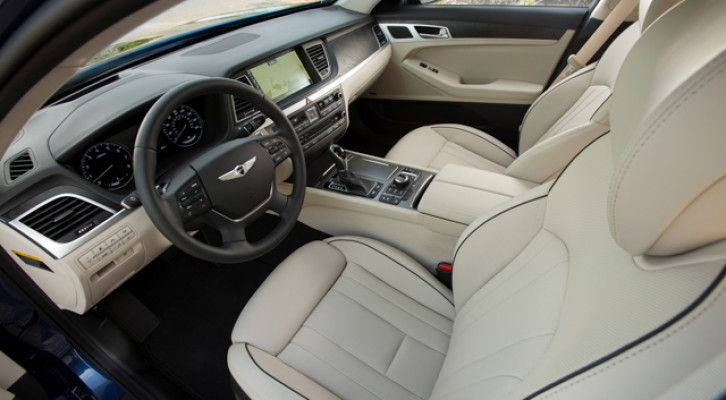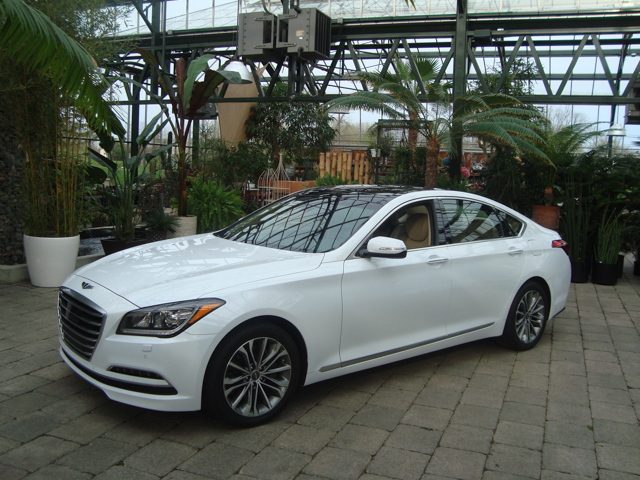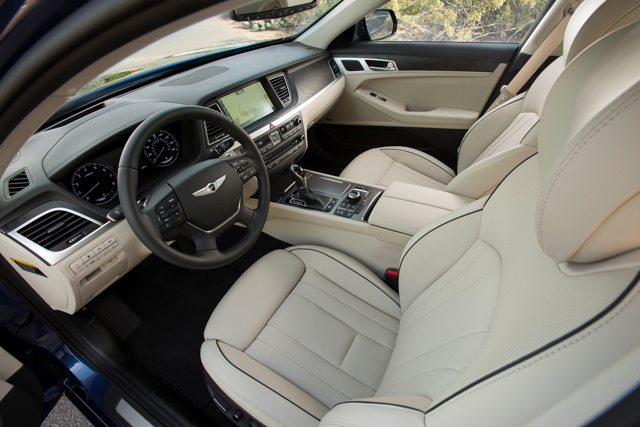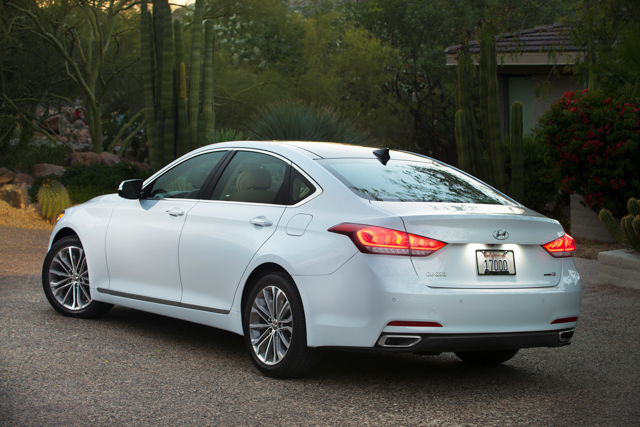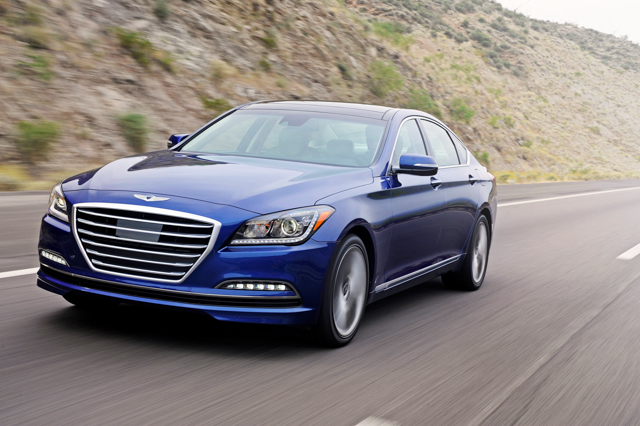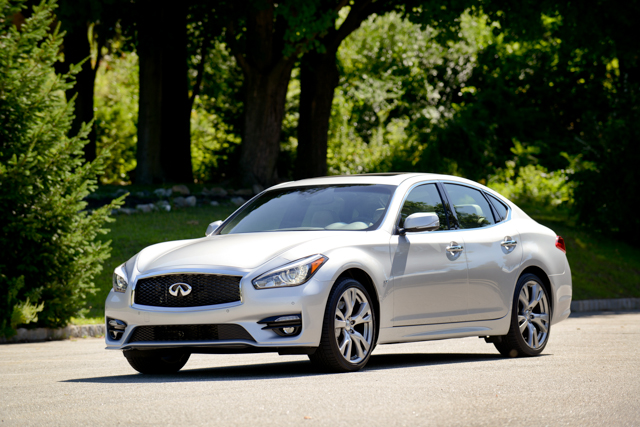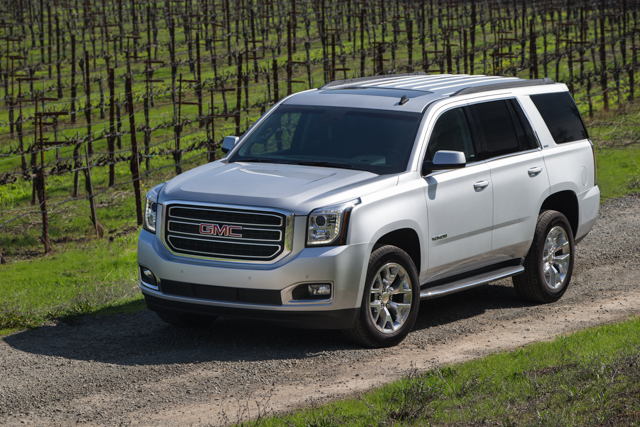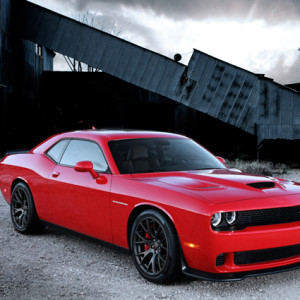Forgoing the usual venue, Hyundai staged the media drive for the 2015 Genesis at a handsome and elegant conservatory tucked away in Bloomfield Hills. It was an appropriate departure from the norm, considering the Genesis’ ongoing march toward establishing a unique identity for itself.
That struggle is what’s interesting about this car. For perspective, the “mid-luxury” segment is huge, totaling over a quarter of a million cars a year. The Genesis accounts for about 20,000 of those sales, because it’s a big pie that’s sliced pretty thin. If there’s one thing Hyundai’s figured out about this hyper-competitive field, it’s that you have to stand out (kind of like being an automotive journalist in Detroit). This is a class of cars that are almost all fantastic vehicles–there are no slouches, and aiming for “average” will result in a car that is Very Nice but is forgotten almost immediately. I’ve driven half of the Genesis’ competitive set in the past few months. That’s a lot of really nice cars: the Audi A6, Mercedes E-Class, Cadillac CTS and Lincoln MKZ, the Volvo S60 and Lexus ES, among others. There is no room for mediocre here.
With that in mind, the new Genesis is a worthwhile evolution of the Korean brand’s bounce into the premium market–but it’s also distinctive. The styling has changed dramatically. The relatively conservative, angled-box design has been replaced by a much more dynamic look that features hints of classic proportions. The hood’s long, the backlight dramatically sloped. The wheelbase is three inches longer, and the tall, vertical grille has a retro-modern feel to it. If the rest of the Hyundai lineup takes influence from the Genesis (and it might) this will probably be looked back on as one of the brand’s handsomest styling periods. Hyundai calls it “Fluidic Sculpture 2.0.” I’m not going to call it that.
Despite the wheelbase stretch, the Genesis is about the same length, so interior room is improved. The cabin is impressively upscaled, of course, and the broad dash with a wide, square console is both in keeping with current automotive fashion as well as providing a unique look. Handsome leather with contrasting piping available in four different colors and a choice of five different wood veneers prevents the Genesis from looking too generic (though the steering wheel looks like it could have been borrowed from a less expensive car) and a head-up display, rotary-dial infotainment interface and big navigation screen (available in eight or nine-inch sizes) ensure an up-to-date look. In terms of technology, Hyundai’s taken a very touchy-feely approach, and the driver aids and luxury items seem to have all been picked to make the Genesis the sort of car that’ll be your friend. The power trunk will automatically open if whoever has the key stands behind the car for more than 3 seconds. The navigation screen doesn’t just interface with smartphone apps (presenting Siri, Pandora and other functions on the screen), it also responds to swipe-type inputs. The expanded satellite radio provides extra channels, and the sound system can record songs directly off of Sirius XM as well as serving as a wi-fi hotspot. Hyundai points out that its BlueLink concierge and emergency-service system provides a range of functions from emergency assistance to vehicle service reports, and goes Mercedes and BMW one better by offering remote start and remote climate control. Meanwhile, back on the road, the head-up display works with the navigation system to provide speed limit information and can even detect school zones with reasonable accuracy.
And if that wasn’t enough, the Genesis’ available equipment includes the Lexicon Logic 7 surround-sound audio system, Genesis logo puddle lamps, a panoramic sunroof, a driver’s seat cushion extender and bolsters, a power trunklid, LED foglights, rear sunshades, illuminated doorsills, and front and rear parking assist. There’s just no way to succeed against Mercedes and Cadillac without a laundry list of luxury items, after all. The new in-cabin CO2 sensor is a new feature that keeps track of the carbon dioxide level in the car to ensure that the driver stays alert. Yes, it will blow fresh air into the car if it detects that the CO2 levels have reached drowsy-making concentrations.
So the new Genesis is pleasant to hang out with. But how does it drive?
Pretty nicely, as it turns out. Hyundai took the opportunity to stiffen and strengthen the chassis when it clean-sheeted the Genesis, resulting in a much more rigid structure that translates to a quieter ride. Die-cast aluminum shock absorber housings up front reduce weight and noise transmission. The suspension uses multi-link construction front and rear. It’s firm without being harsh, so it strikes a nice balance between comfort and poise. Lateral stability is very good, so while the Genesis doesn’t corner like a sports car, it feels poised and confident when it does. The optional Continuous Damping Control is new, and offers Normal, Sport, Eco and Snow modes. Rack-mounted power steering replaces EPS, and offers variable ratios. The Genesis took some trips to the Nürburgring, which is kind of a must-do for sporty-vehicle development these days.
Wait, “sporty?” Well, once again, being in the ring with Mercedes, Audi and BMW requires a certain level of athleticism. The Genesis isn’t a sport sedan per se, but these days luxury cars are expected to have athletic moves, as well. A choice of direct-injection 3.8 V6 and 5.0 V8 engines is offered, of course. The Genesis’ engines produce 311 and 420 horsepower, respectively. Power levels are reasonable in both models, though the V8 has a more ponderous feel. I preferred the V6, which felt smoother and equally confident. Eight-speed automatic transmissions put the power to the road in all models.
All-wheel drive is available in the Genesis for the first time, because you can’t come to a party that Audi’s at without it. Hyundai’s HTRAC all-wheel drive system splits power dramatically front to rear–up to 90% to the rear if needed. It’s only available with the V6 and adds a measure of sure-footedness that helps this big car keep up with its own bulk in the corners.
Going beyond the all-wheel drive, a range of active electronic driver aids is also on hand. Hyundai has made sure to check the intelligent cruise control, blind-spot detection, rear cross-traffic alert and lane-change assist boxes. The lane-change assist checks for fast-approaching vehicles as well. The Genesis’ lane-keeping assist enables the driver to adjust the level of intervention. The new Automatic Emergency Braking system uses camera sensors to detect an impending forward crash, and can brake to reduce the accident or avoid it entirely.
All of that adds up to a Very Nice Car. So what about all of those other Very Nice Cars in its class? Well, the Genesis’ new style is what will set it apart; it’s got enough personality to give you a reason to fall in love with it (the Cadillac CTS, Audi A6 and Volvo S60 accomplish this as well, in different flavors) and that’s what it’ll take to make a mark in this group.
Where the “near-luxury” distinction comes in is with the price. The Genesis is loaded with amenities but still manages to undercut many of its competitors, with the 3.8 V6-equipped models starting at $38,000. You’ll pay $40,500 for all-wheel drive, and the starting price for the 5.0 Genesis jumps to 51,500. A fully loaded car barely touches the lower range of the full-luxury Equus, at about $54,000.

